Culture models for studying thyroid biology and disorders
- PMID: 22363871
- PMCID: PMC3262635
- DOI: 10.5402/2011/275782
Culture models for studying thyroid biology and disorders
Abstract
The thyroid is composed of thyroid follicles supported by extracellular matrix, capillary network, and stromal cell types such as fibroblasts. The follicles consist of thyrocytes and C cells. In this microenvironment, thyrocytes are highly integrated in their specific structural and functional polarization, but monolayer and floating cultures cannot allow thyrocytes to organize the follicles with such polarity. In contrast, three-dimensional (3-D) collagen gel culture enables thyrocytes to form 3-D follicles with normal polarity. However, these systems never reconstruct the follicles consisting of both thyrocytes and C cells. Thyroid tissue-organotypic culture retains 3-D follicles with both thyrocytes and C cells. To create more appropriate experimental models, we here characterize four culture systems above and then introduce the models for studying thyroid biology and disorders. Finally, we propose a new approach to the cell type-specific culture systems on the basis of in vivo microenvironments of various cell types.
Figures

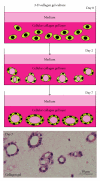

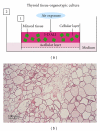
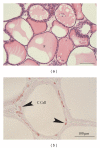
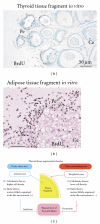
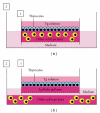

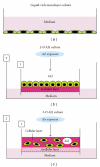
References
-
- Fawcett DW. The thyroid gland. In: Fawcett DW, Raviola E, editors. Textbook of Histology. New York, NY, USA: Chapman & Hall; 1994. pp. 490–502.
-
- Pulvertaft RJV, Davies JR, Weiss L, Wilkinson JHJ. Studies on tissue cultures of human pathological thyroids. The Journal of Pathology and Bacteriology. 1959;77(1):19–32. - PubMed
-
- Takasu N. Primary culture of thyroid cells. In: Griffiths JB, Doyle A, Newell DG, editors. Cell and Tissue Culture: Laboratory Procedures. 17B (1) Chichester, UK: John Wiley & Sons; 1996. pp. 1–13.
-
- Toda S, Sugihara H. Primary culture of the thyroid: three-dimensional culture using extracellular matrix. In: Griffiths JB, Doyle A, Newell DG, editors. Cell and Tissue Culture: Laboratory Procedures. 17B (2) Chichester, UK: John Wiley & Sons; 1996. pp. 1–12.
-
- Toda S, Koike N, Sugihara H. Thyrocyte integration, and thyroid folliculogenesis and tissue regeneration: perspective for thyroid tissue engineering. Pathology International. 2001;51(6):403–417. - PubMed
LinkOut - more resources
Full Text Sources
Other Literature Sources

